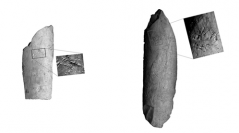

 Comptes Rendus Palevol
11 (4) - Pages 283-292
Comptes Rendus Palevol
11 (4) - Pages 283-292Retouching tools made of bone and other hard animal material have very broad chronological and geographical distribution throughout the Paleolithic period in Europe that also involves the Latest Mousterian and the Uluzzian in Italy. We investigated possible behavioural differences between these two cultural complexes in the use of these implements, based on the evidence from Fumane Cave, with its MP-EUP transitional sequence that has so far yielded more than 150 such artifacts. Although they are mostly made from bone shafts, a few remarkable examples of two fragments of cervid antler are also present. At a general level, these tools form an homogenous group: taxonomically, the bones fit with the faunal composition dominated by red deer and cervids, which were the most commonly hunted animals. The identified stigmata are punctiform impressions, linear impressions, striae and wells, usually grouped in small zones. Each retouching tool has up to three of these zones. Significant similarities in species, the skeletal part, and weight between the tools from the two cultural complexes have been detected, but also a difference due to the use of brown bear bones in the Uluzzian.
Retoucher, Bone, Mousterian, Uluzzian, Italy